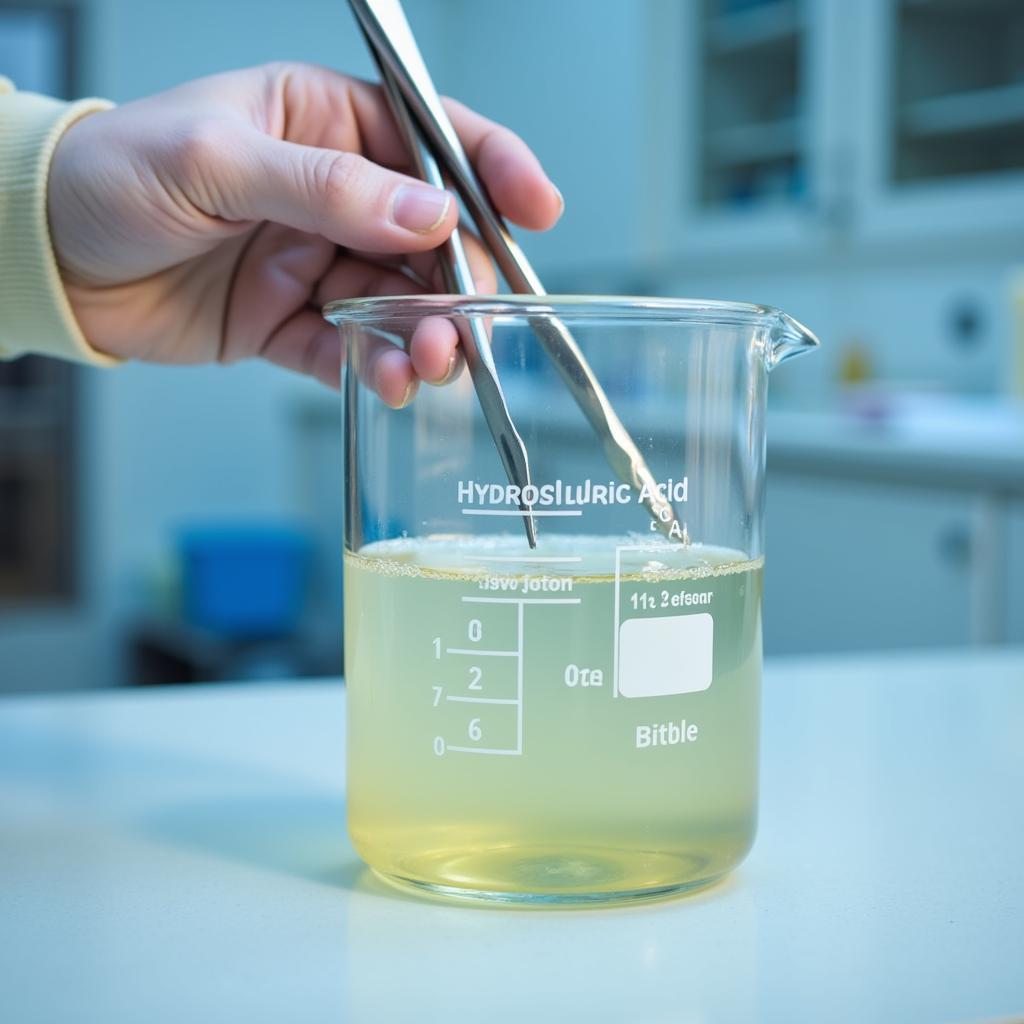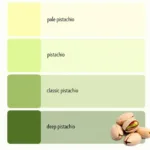Hydrochloric acid (HCl) is a common chemical used in various industrial, laboratory, and even household settings. But what color is hydrochloric acid? Surprisingly, pure hydrochloric acid is a colorless liquid. However, impurities can lead to slight variations in its appearance. This article will delve into the color of hydrochloric acid, its properties, uses, and safety precautions.
What does pure hydrochloric acid look like? In its pure form, hydrochloric acid is completely transparent and colorless, much like water. However, commercial grades of HCl often contain impurities that can give it a slightly yellowish tint. This yellow discoloration is typically due to the presence of iron ions or other contaminants.
Understanding Hydrochloric Acid Properties
Hydrochloric acid is a strong acid, meaning it completely dissociates in water. This characteristic makes it highly reactive and corrosive. Its chemical formula, HCl, indicates it’s composed of hydrogen and chlorine. It’s crucial to understand its properties to handle it safely and effectively.
Concentration and Color Variations
The concentration of hydrochloric acid plays a role in its appearance. While pure HCl is colorless, highly concentrated solutions may sometimes exhibit a slight yellow tinge due to the increased presence of impurities. Dilute solutions, on the other hand, typically retain their colorless nature.
What color does acid turn litmus? This question relates to how we identify acids.
 Hydrochloric acid in a laboratory setting
Hydrochloric acid in a laboratory setting
Uses of Hydrochloric Acid
Hydrochloric acid’s reactivity makes it valuable in various applications across different industries.
Industrial Applications
In industrial settings, HCl is used in large-scale processes like steel pickling, which removes rust and scale from steel surfaces before further processing. It’s also used in the production of various chemicals, including PVC (polyvinyl chloride) and other polymers.
Laboratory Uses
In laboratories, hydrochloric acid is a common reagent in titrations and other analytical procedures. It’s also used to adjust the pH of solutions and as a catalyst in certain reactions.
Household Applications
Even in households, diluted hydrochloric acid finds use as a cleaning agent, particularly for removing stubborn stains and mineral deposits. However, due to its corrosive nature, extreme caution is advised when using it at home.
Safety Precautions When Handling Hydrochloric Acid
Hydrochloric acid is a hazardous substance and requires careful handling to avoid accidents. Always wear appropriate personal protective equipment (PPE) such as gloves, eye protection, and lab coats.
Inhalation Hazards
Inhaling HCl fumes can cause severe respiratory irritation and even lung damage. Always work in a well-ventilated area or under a fume hood when handling concentrated hydrochloric acid.
Skin Contact
Skin contact with hydrochloric acid can result in chemical burns. Immediately flush the affected area with plenty of water if contact occurs.
 Safety precautions when handling hydrochloric acid
Safety precautions when handling hydrochloric acid
Conclusion
So, what color is hydrochloric acid? Pure hydrochloric acid is colorless, while impurities can cause commercial grades to appear slightly yellow. Understanding its properties and potential hazards is vital for safe and effective use. Remember to always prioritize safety and handle hydrochloric acid with care.
FAQs
-
Is hydrochloric acid always yellow? No, pure hydrochloric acid is colorless. The yellow tint often seen in commercial grades is due to impurities.
-
Can I use hydrochloric acid at home? Diluted hydrochloric acid can be used as a cleaning agent, but exercise extreme caution and wear appropriate PPE.
-
What should I do if I inhale hydrochloric acid fumes? Immediately move to a well-ventilated area and seek medical attention if necessary.
-
Is hydrochloric acid the same as muriatic acid? Yes, muriatic acid is a less pure, diluted form of hydrochloric acid often sold in hardware stores.
-
How do I dispose of hydrochloric acid safely? Neutralize the acid by slowly adding it to a base like baking soda, then dispose of the neutralized solution according to local regulations.
-
What is the pH of hydrochloric acid? The pH of hydrochloric acid varies depending on its concentration, but it’s typically very low, indicating a highly acidic solution.
-
What materials are compatible with hydrochloric acid storage? Hydrochloric acid should be stored in containers made of glass or certain plastics resistant to its corrosive properties.
Scenarios
-
Scenario: You see a bottle of clear, colorless liquid labeled “HCl”. Question: Is this likely pure hydrochloric acid? Answer: Yes, pure hydrochloric acid is colorless.
-
Scenario: You notice a yellow tint in your hydrochloric acid solution. Question: Should you be concerned? Answer: A slight yellow tint can be normal due to impurities, but excessive discoloration may indicate contamination.
-
Scenario: You accidentally spill hydrochloric acid on your skin. Question: What should you do? Answer: Immediately flush the affected area with plenty of water and seek medical attention if necessary.
Further Reading
For more information on acids and bases, you can visit our article on what color does acid turn litmus.
Need Help?
For assistance with color selection or any other inquiries, contact us:
Phone: 0373298888
Email: [email protected]
Address: 86 Cầu Giấy, Hà Nội.
Our customer service team is available 24/7.

